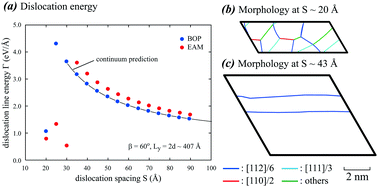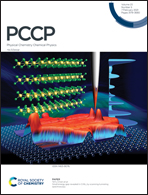Abstract
Dislocation core energy is an important property in materials mechanics but can only be obtained from atomistic simulations. Periodic boundary conditions are ideally suited for atomistic calculations of dislocation energies but have faced two major challenges. First, viable methods to extract core energies from atomistic data of total energies have been developed only for non-dissociated dislocations whereas realistic dislocations are often dissociated into partials. Second, core energy is a function of dislocation character angle. This functional dependence can only be revealed through calculations at a variety of character angles. This requires both additional computational resources and a robust method to implement arbitrary character angles. Here a new procedure has been developed to overcome both challenges. By applying this approach, we have calculated 22 core energies of dissociated dislocations in aluminium over the entire character angle range between 0° and 90°. In addition to the discrete core energy data for dissociated dislocations, we found that core energy can be approximated by a continuous function of character angle. Specifically, our dissociated dislocation core energies have been well fitted to a polynomial Sinoidal function of character angle. We have also discovered that there exists a critical system dimension below which dislocation core energies cannot be calculated due to dislocation transformation.

- This article is part of the themed collection: 2021 PCCP HOT Articles


 Please wait while we load your content...
Please wait while we load your content...